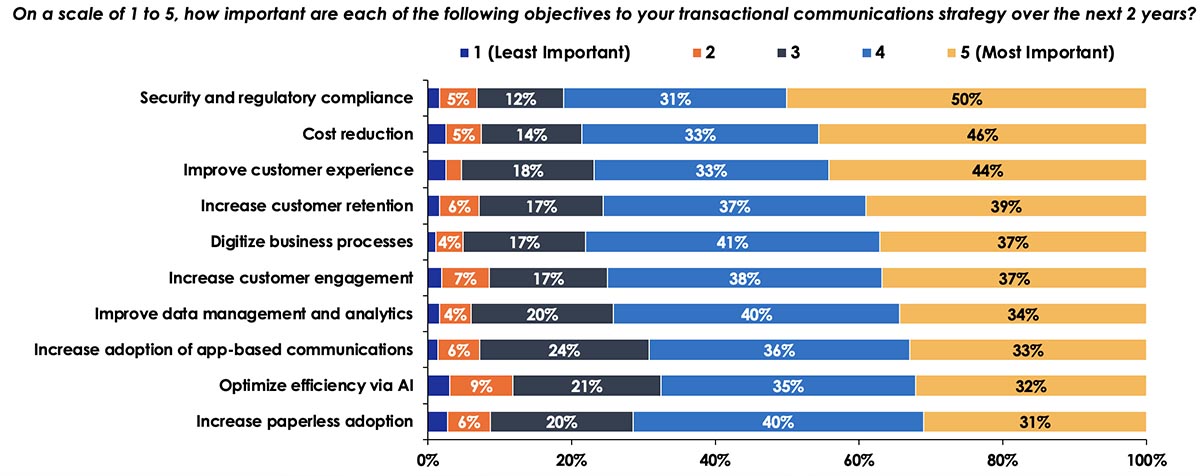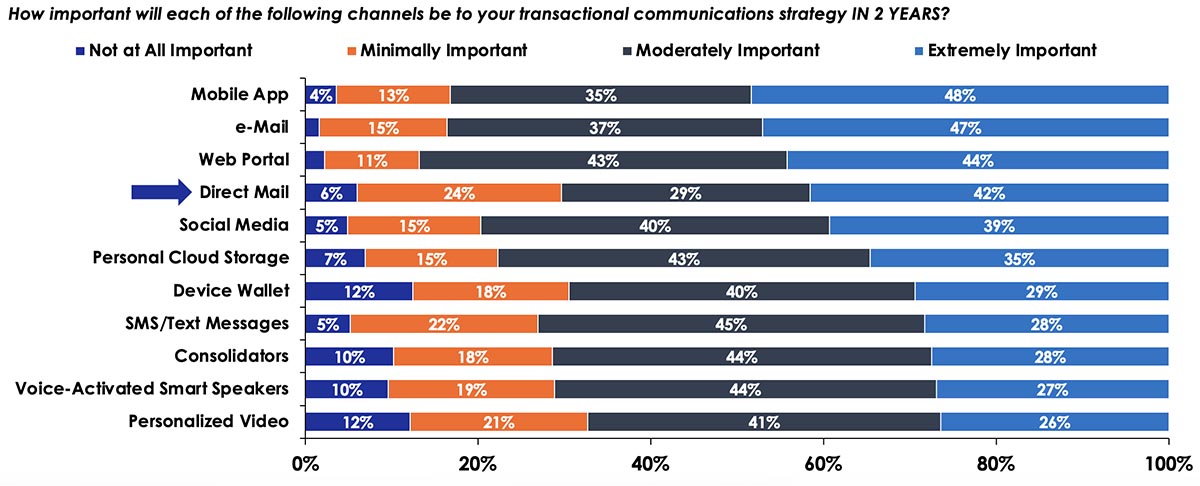- To ensure customer satisfaction, enterprises must focus on the overall customer journey rather than cost reduction.
- Rather than focusing on migrating all consumers from printed to digital communications, the goal should be to deliver a transformative customer experience that will steadily build solid relationships, increase loyalty, and drive revenues.
- Although there is no question that the use of mobile apps, social media, and web portals will continue to grow, Keypoint Intelligence’s research confirms that printed direct mail will also remain important to enterprises’ transactional communication strategies.
By Eve Padula
Introduction
In today’s digital world, it is now more important than ever for businesses to deliver the digital experience that most of their customers have come to expect. Firms of all types and sizes are competing to capture consumers’ attention, and personal online experiences have conditioned consumers to expect a customized and relevant experience from all their providers. The digital reality has caused a shift in communication strategy, and the focus should be on improving the customer experience with superior interaction. Many businesses feel compelled to ramp up their digital communication strategies in response to consumers’ demands, but print can—and should—play a role in the communications of the future. Even in a digital first world, printed communications can be used strategically to help improve the customer experience.
Top Business Objectives Drive Future Growth Strategies
Keypoint Intelligence’s most recent Transactional Communications research asked businesses to rank the importance of various business objectives in relation to their future transactional communication strategies. According to the survey results, enterprises assigned the highest importance to security and regulatory compliance, cost reduction, and improving the customer experience.
Figure 1: Importance of Business Objectives

N = 364 Total Enterprises in the US and Canada
Source: Annual State of Transactional Communications Business Survey; Keypoint Intelligence 2021
Two of these top objectives—cost reduction and improving the customer experience—are affecting many enterprises’ strategies for future growth. Additional insight is provided in the subsections that follow.
Cost Reduction
As previously shown in Figure 1, 46% of total enterprises ranked cost reduction as a top business objective (assigning it a score of 5 out of 5). When these specific respondents were asked how they planned to reduce costs, the most common tactic was increasing paperless adoption (cited by 69% of respondents).
Many businesses might strive to push more of their customers to paperless communications as they work to reduce costs. Although this strategy can be effective, the potential for lower costs will mean little if it comes at the expense of customer satisfaction. Some customers may welcome a shift to paperless, but others might be opposed to it. A paperless adoption strategy won’t lower your costs if calls to customer service go up or additional correspondence must be sent to frustrated customers. This strategy can also backfire if you end up losing customers to a competitor that is offering a better experience. To ensure customer satisfaction, enterprises must focus on the overall customer journey rather than cost reduction.
Improving the Customer Experience
There is no denying that the digital transformation is upon us, but simply committing to a digital first strategy is not enough. Rather than focusing on cutting costs by migrating all consumers from printed to digital communications, the goal should be to deliver a transformative customer experience that will steadily build solid relationships, increase loyalty, and drive revenues. Ultimately, a positive customer experience can be a compelling competitive differentiator in today’s marketplace. Therefore, it should come as little surprise that an improved customer experience ranked right up there with reducing costs in terms of enterprise business objectives. As seen in Figure 1, 44% of total enterprises considered improving the customer experience to be a top business objective.
When these respondents were asked to specify how they planned to improve the customer experience, the most common tactics included:
- Expanding mobile offerings (45%)
- Improving data hygiene/address validation (45%)
- Improving interaction with customers via social media (43%)
The Importance of an Omni-Channel Communication Strategy
Customers have countless opportunities to interact with brands in today’s digital world, but this doesn’t mean that all these interactions should be digital. Let’s face it—technologies and dashboards aren’t always easy for everyone to navigate. When customers are met with friction, they will be left feeling disconnected and frustrated. As a result, enterprises that are attempting to lower their costs by pushing all customers toward a paperless strategy will likely see their efforts backfire among those customers who prefer paper-based communications.
The great debate of paper vs. paperless will always be incomplete if consumers’ preferences aren’t considered. Although there is no question that the use of mobile apps, social media, and web portals will continue to grow, Keypoint Intelligence’s research confirms that printed direct mail will also remain important to enterprises’ transactional communication strategies.
Figure 2: Importance of Channels to Communication Strategy

N = 364 Total Enterprises in the US and Canada
Source: Annual State of Transactional Communications Business Survey; Keypoint Intelligence 2021
The data in the previous chart confirms that an omni-channel communication strategy is a solid approach for enterprises that are hoping to keep their costs in check while still delivering a positive customer experience. Moreover, today’s technologies can address consumers’ changing preferences regardless of device or location. Forcing consumers into a single format with no regard for their preferences will result in a poor customer experience. Organizations that have already made the leap to a true omni-channel experience—one that makes the best use of all channels—will be able to communicate more effectively.
Ultimately, the desire to reduce costs and the need to deliver a better customer experience can go hand in hand. Organizations can influence the digital adoption/paper suppression trend by positioning paperless adoption as a vehicle for achieving an improved customer experience. Thanks to ongoing advancements in electronic communications, going digital is easier than ever before. If customers and clients can connect with your business digitally, you’ll have many more opportunities to enhance the overall customer experience via these interactions. Enterprises should highlight the benefits of paperless adoption, including speed, accuracy, cloud storage/delivery, and advanced archiving capabilities.
The Bottom Line
The transformation to digital has only accelerated over the past few years, and this shift shows no signs of slowing. Today’s consumers have come to expect digital engagement options, so enterprises must deliver on these expectations to remain competitive. In this new digital reality, the communication strategy must shift. Rather than focusing on reducing costs, enterprises must concentrate on improving the customer experience with superior interactions across all communication channels. Businesses need to deliver a transformative customer experience by putting the customer at the center of the journey and embracing an omni-channel experience. This strategy will build solid relationships, increase loyalty, and ultimately drive revenues.
Eve Padula is a Senior Consulting Editor for Keypoint Intelligence’s Production Services with a focus on Business Development Strategies, Customer Communications, and Wide Format. She is responsible for creating many types of content, including forecasts, industry analyses, and research/multi-client studies. She also manages the writing, editing, and distribution cycles for many types of deliverables.









